
Abstract
Automatic evaluation of language generation systems is a well-studied problem in Natural Language Processing. While novel metrics are proposed every year, a few popular metrics remain as the de facto metrics to evaluate tasks such as image captioning and machine translation, despite their known limitations. This is partly due to ease of use, and partly because researchers expect to see them and know how to interpret them. In this paper, we urge the community for more careful consideration of how they automatically evaluate their models by demonstrating important failure cases on multiple datasets, language pairs and tasks. Our experiments show that metrics (i) usually prefer system outputs to human-authored texts, (ii) can be insensitive to correct translations of rare words, (iii) can yield surprisingly high scores when given a single sentence as system output for the entire test set.